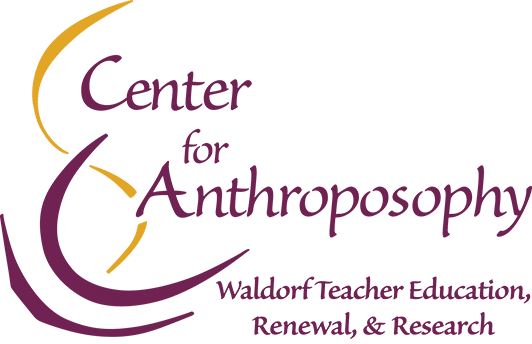 Education entails movement. In kindergarten, the movement is primarily physical. In the lower school movement goes inside and becomes more subtle as psychological movement, so that students are inwardly moved or inspired to learn in a mood of wonder. By the high school years the emphasis has been elevated into more intellectual realms, where flexibility in thinking takes the theme of movement yet one stage higher.
Education entails movement. In kindergarten, the movement is primarily physical. In the lower school movement goes inside and becomes more subtle as psychological movement, so that students are inwardly moved or inspired to learn in a mood of wonder. By the high school years the emphasis has been elevated into more intellectual realms, where flexibility in thinking takes the theme of movement yet one stage higher.
In this issue of Center & Periphery, we explore movement in its various guises. Whether through the metaphors of air travel or ripples across a pond or walking a labyrinth, or in movement across international frontiers, the dislodging of intractable issues, or the inner sea changes born of anthroposophical studies –– or even the shifting of fresh supplies from the shelves of our Color Shop & More, the Center for Anthroposophy is on the move this term.
Come journey with us through this issue!
Douglas Gerwin, Director
Center for Anthroposophy
In this Issue
Dateline Vienna, Austria: Many Rivers, One Ocean
From all corners of the world, Waldorf teachers concerned with adult education converged this month on Vienna, home to Rudolf Steiner during his undergraduate years, for a triad of conferences concerning the tasks and travails of Waldorf education. Douglas Gerwin was in attendance.
Think of Waldorf schools and institutes around the world as a network of rivers, each originating in some high mountain source and flowing through a host of different landscapes with many levels of intensity and prominence. Some trickle almost unnoticed through a remote forest, others surge through the center of a great metropolis. Some meander, others leap over giant cataracts. Some meet in central points of confluence, others chart a solo course for hundreds of miles. In the end, however, they all flow towards the same goal –– the ocean, where they find their common end as well as the beginning of a shared source of renewal.
With this sweeping image, Florian Osswald, Co-Leader with Claus-Peter Roeh of the Pedagogical Section at the Goetheanum in Dornach, Switzerland, painted a grand and living picture of the many institutions around the world involved in Waldorf teacher education. His point was to reconcile a dizzying variety of Waldorf teacher training institutes, on the one hand, with their overarching shared goals and dreams, on the other.
During the first week of May, representatives from all manner of Waldorf institutes came together in Vienna, Austria for a series of three conferences, each with its own organizers and specific mission. The first, billed as an “educational congress”, was arranged by the European Network for Academic Steiner Teacher Education (ENASTE), a loose collection of European adult education colleges and institutes devoted to a more academic pursuit of Waldorf education at the level of higher education. The second conference, a more intimate affair spearheaded by representatives of the Pedagogical Section, allowed Waldorf teacher trainers from all six continents to hear from each other their dreams and struggles, and to engage in some shared artistic movement as a way of getting to know each other better –– or at least to remembering one another’s names. Finally, these same teacher educators met with members of the Hague Circle (now called the “International Forum for Waldorf/Steiner Schools”) for a series of group discussions on the deeper impulses behind Waldorf education. In between there was time for leisurely lunchtime conversations or the chance to discover the places in Vienna where Rudolf Steiner lived and studied as a young man, including the Café Griensteidl (recently reconstructed) where he penned his first full-scale book.
Among some 40 institutes represented at one or more of these conferences, a few were long-established Waldorf colleges or long-standing Waldorf programs embedded in an existing university, such as the Waldorf program in the education department of Antioch University New England in Keene, NH. Others, by contrast, were fledgling in-service programs attached to a young Waldorf school in some far-flung hinterland. Most of them––outside the United States, that is––said they receive state funding, with varying degrees of strings attached to this form of support.
Specific presentations were made by representatives of teacher training programs from the U.S., Brazil, and South Africa. In each of these one could hear how local ethnic groups struggled to overcome what one representative called the “Waldorf imperialism” originating in earlier days from Europe. One workshop presenter told the story of two Waldorf early childhood trainers who traveled to Asia from Europe –– one with a suitcase filled with European materials including wool (a material not readily available in that part of the world), the other with little in her luggage but who began her course on making Waldorf dolls by taking her students to the local market to buy indigenous fabrics. Here it became obvious that the Waldorf “rivers” need to be adapted to the cultural terrain through which they flow, even though they carry with them something from a transcendent and spiritually inspired source (called anthroposophy).
A complementary topic to this theme of cultural diversity was the subject of inter-relationships or coherence in the learning process. Many of the speakers during the first days of the academic congress stressed this theme as a fruitful subject of research, whether it applied to the learning relationships––both “explicit and implicit”–– between caregiver and young child or to the developing brain and the sensory environment that shapes it. In an evocative closing to the congress, Peter Lutzker, a docent from the Stuttgart teacher training school and research institute, introduced the notion of “attunement” as a way of capturing the subtle relationship between teacher and student. With a wealth of metaphors drawn from the musical arts (how appropriate for a congress in Vienna!), he gently elevated the art of attuned silence––or “Schweigen” in German––to a potent pedagogical practice. His talk reminded me of a bumper sticker: “We teach by listening, we learn by speaking.”
During the final two days, the institute representatives were joined by members of the International Forum, swelling the circle to some 70 Waldorf teachers from 35 countries. For these discussions, the setting shifted from the city center to the Wien West Rudolf Steiner School, close to the legendary Schloss Schoenbrunn of Empress Maria Theresa on the outskirts of town. Here it was possible to attend a scene from a play depicting the story of King Arthur, performed in English by the school’s sixth grade, and to break into smaller working groups on contemporary topics in Waldorf education.
With such a diverse group, generalizations are dangerous. At the risk of over-simplification, however, there were some common themes that resounded repeatedly during the week. One was the increased pressure being felt among Waldorf institutes great and small to conform to externally determined norms, such as standardized tests or government regulations. Another concerned the paucity of Waldorf trained teachers––especially at the high school level––and the reluctance in some quarters to ground teachers in Waldorf pedagogy. Another concerned the lack of “cultural literacy” and artistic repertoire among teachers, especially the younger ones. Another concern focused on the broad range of remedial needs among the children, and the shortage of expertise to help teachers who face a broadening range of children in need of remedial help.
No description of a week in Vienna would be complete without reference to the artistic treasures of this city, which for two centuries and more was the cultural center of Europe and the imperial capital of the Hapsburg empire. Virtually every street bears a plaque to some celebrated artist. During his 11 years in Vienna, for instance, Mozart lived at 13 different addresses, Beethoven at more than 60 apartments in and around the city. No evening passes here without a concert somewhere devoted to Mozart or Johann Strauss: even the subterranean public bathrooms in the subway station between the opera house and Musikverein concert hall advertise free piped recordings of these two favored composers. Around the Ring Road (formerly the town wall that defined the inner city) a string of immense palaces houses priceless collections of painting and sculptures and artifacts of war, to say nothing of the 8,000,000 volumes collected over the centuries in the Hapsburg’s giant library and (now public) national archives.
Many of these buildings stem from the period of the Baroque (1600-1750, roughly) and would therefore have served as backdrop to Rudolf Steiner’s years as a student at the technical university in Vienna. Three blocks from the imposing apartment block where Steiner lived as a private tutor to children of the Specht family, one can visit the second-story flat of his contemporary, Sigmund Freud, whose home and famous study (minus the celebrated couch, which Freud took with him to London when he fled the Nazis in 1938) have recently been refurbished as an extended museum and library.
One final note: A first-time visitor may be surprised not to find the Danube coursing through the Austrian capital. A dull industrial canal––a man-made offshoot of the legendary river––skirts the northern part of the city, well away from the cultural center. The Danube itself misses the capital by several miles, and is neither blue nor beautiful. That’s one river that has masked its transcendent origins.
Dateline Seattle, WA: Wheels Up, But What About the Rest of It?
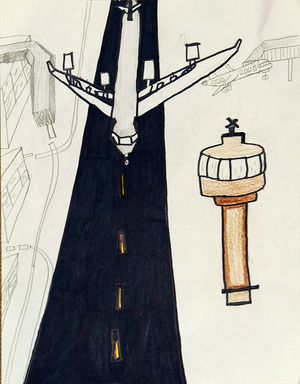 After a series of flights in aircraft small and large, our peripatetic reporter muses on the aerodynamic forces that kept him airborne –– and poses some questions of the reader about how they can help buoy our schools, too.
After a series of flights in aircraft small and large, our peripatetic reporter muses on the aerodynamic forces that kept him airborne –– and poses some questions of the reader about how they can help buoy our schools, too.
According to the Boeing Corporation (and they have good reason to keep track of statistics like these), some 6,000,000 people on average take to the air each day. By my count, depending on the length of their flights, there must be some 600,000 to a million passengers in the air around the globe at any one moment. That would be the equivalent of catapulting the population of Rome into permanent orbit.
All of these passengers are successfully vaulted into the sky by two pairs of polar opposite forces. These forces apply in all cases, whether to a soft-landing seaplane or a hard-impact jumbo jet.
The first pair of forces––thrust versus drag––determines how fast or slowly the plane will travel. As forces of physical nature, they are well understood, since they accelerate or retard movement by much the same laws on the ground as in the air. As forces of psychological nature, they are equally familiar to anyone who has ever endured a long and arduous main lesson or faculty meeting. (When we were children, my older brother and I actually embodied these forces of retarding drag and accelerating thrust. He was known as “Come-along!” while I, a second-born, was known as “Wait-a-minute!”)
The second pair of forces that affect flying is more mysterious and not so easily understood –– not even by pilots, it seems. These forces determine the success of take-off and of landing and, perhaps more important, of staying aloft. Passengers sitting over the wing of an aircraft and looking out the window may have observed wisps of cloud-like streamers whizzing over the wing’s curved surface, especially during take-off or landing, and they may recall having been told (perhaps in school) that the plane rises or stays in the atmosphere because the curvature of the wing coerces air to pass across the top surface more swiftly than under the bottom surface, and that this differential “sucks” the plane up into the sky. This phenomenon is named the Bernoulli effect after the Swiss scientist Daniel Bernoulli (1700-1782), who anticipated the law of conservation of energy and whose father (Johann) and uncle (Jakob) made important strides in developing the mathematical calculus along with their contemporaries Isaac Newton and Gottfried Wilhelm von Leibniz.
I have had pilots with four golden stripes emblazoned upon their cuffs invoke Bernoulli as the explanation for how they managed to coax an airplane into the sky. While the application of this principle to plane flight is not wrong, it accounts for only a tiny fraction of the force needed to lift a small or mighty plane into the air. Far more important, it turns out, than the curvature of the wing is its angle, which sets up a huge downdraft behind the wing that in turn––thanks to Newton’s law of equal and opposite action and reaction––creates a matching column of rising air. And that, much more than the Bernoulli effect, lobs the plane into the sky. As one engineer described it to me, a loaded jumbo jet––some 450 tons of it or the equivalent of 100 adult elephants strung together by their proboscides––creates a mattress of air some 20 stories deep to sustain and cushion the ride, as it were.
In short, it is the simultaneous collaboration of two complementary forces––thrust and drag, on the one hand; downpush (also known as gravity) and uplift (which in earlier times used to be called “levity”), on the other––that makes flight possible. We can say, further, that these complementary forces will prevent the plane from falling out of the sky –– but only (and here is the catch) for as long as the plane keeps moving.
I have already hinted where one may find the first pair of forces––accelerating thrust and retarding drag––at work in Waldorf schools. But what of the second pair: What are the forces that push us down, or that buoy us up? What happens when these complementary forces are out of balance? And what are the consequences to our schools when we stop moving?
I invite your comments and suggestions, which I hope to publish in a future issue of Center & Periphery. Please send me your responses via e-mail to histep@centerforanthroposophy.org. I look forward to hearing from you!
Dateline Amherst, MA: Ripple Effect
 Waldorf education is all about raising and broadening consciousness, in adults no less than among children. Douglas Gerwin, Director of the Center for Anthroposophy, looks at seven concentric rings of adult consciousness as they apply to the wellbeing of children in Waldorf schools.
Waldorf education is all about raising and broadening consciousness, in adults no less than among children. Douglas Gerwin, Director of the Center for Anthroposophy, looks at seven concentric rings of adult consciousness as they apply to the wellbeing of children in Waldorf schools.
Drop a pebble into the middle of a still pond and watch how the ripples begin to expand outward, one after the other. Amazing, is it not, how far they will stretch, extending to the edge of the shoreline. Even then their pulsing energy is not expended, for if you watch carefully you will notice how these same ripples begin to work back on themselves, retreating from the shore and gently wafting out across the pond, perhaps even intersecting with younger ripples that continue to originate from the place where the pebble first fell into the water.
This ripple effect reminds me of what can happen to your circle of attention when you place your child in a Waldorf school. To begin with, your attention will be focused in a tight protective circle around your own child and how it is growing and developing. But with time––especially if your child is thriving––your horizon of consciousness may expand beyond this first ring of attention to embrace a second and wider circumference: namely, the health and harmony of your child’s entire class, especially if it is led by a loving kindergarten or elementary grade school teacher. (The picture changes somewhat in the high school when a single class teacher hands over the class to a faculty of subject teachers, and students take at least some of their classes across the grades.)
But this “class” perspective can expand much further –– five concentric circles further. Beyond the circumference of the class one can become aware of the circle of the entire school, and beyond that the circular horizon of Waldorf schools within an entire nation or––as is the case with the Association of Waldorf Schools of North America (AWSNA)––an entire continent. But we will feel the life of the Waldorf movement even more strongly if we can broaden our gaze further to embrace the entire family of Waldorf schools worldwide –– over a thousand schools located on all but one continent of the globe. (There are no Waldorf schools in Antarctica, but then there are no children there, either.)
With this fifth circle of consciousness, expanded to include Waldorf schools around the globe, we may think we have reached the widest embrace. But two greater ripples yet remain: one is the circle of “sister organizations” that are integral to the success and survival of Waldorf schools. I think here especially of the institutes that prepare Waldorf teachers for the classroom, but also of the centers where specialists train as Bothmer gymnasts or eurythmists, speech artists or Werbeck musicians, Christian Community priests or anthroposophical physicians, Waldorf remedial teachers or a host of therapeutic professionals inspired by the work of Rudolf Steiner. They too play formative roles in educating a growing child.
Finally there is a seventh and all-embracing ripple. Rudolf Steiner called it “the Spirit of the Waldorf school”, a potent spiritual reality that hovers over each Waldorf school––however diverse one from the other––and over the Waldorf movement as a whole, however far flung the schools are from each other. Without this Spirit there would be no Waldorf school, and without the schools who can say how this Spirit would be effective in the world.
It takes a whole pond to educate a whole child.
Dateline Wilton, NH: A New Round of Renewal
Karine Munk Finser, Coordinator of CfA’s Renewal Courses, sketches a dazzling line-up of faculty presenters –– several of them offering courses in this two-week summer program for the first time.
“You have been joined together by fate, to unfold the powers which are to serve a good creative work. Wisdom itself will teach you, as you walk on the soul’s path, that greatest things can be achieved when souls who give each other spirit certainty, unite in work toward the healing of the world- in faithfulness.”
– Benedictus, in The Portal of Initiation by Rudolf Steiner
If I were to explain Rudolf Steiner’s mission in a few simple words, I would say it is to make sure we do not get lost here on earth. Truly, as we look to events around the world or very close to home, we can see how easy it is to get quite lost. Not getting lost means being able to find one’s way home –– that is, to find one’s way back to the spiritual world.
As we grow older we become more aware of the approaching path of return but also of the importance of becoming present to the people around us and to do “good creative work”. There is nothing more life-affirming or inspiring than to hear one’s own inmost voice spoken by another, or to share one’s thoughts, or to practice art side by side, to develop new capacities, or to discuss and find new entries into life’s questions.
We are delighted once again to be offering courses this summer that will touch upon such possibilities: Renewal 2013 has been carefully planned for you and we feel quite certain that you will find a course that speaks to you.
So, who is coming to teach this summer? Our new faculty this year includes Michaela Gloeckler, Margot Amrine, Charles Andrade, Paul Matthews, Peter Snow, Wendy Bruneau, Penelope Baring, Elena Efimova, and Eleanor Winship.
Faculty who are returning this summer, some of them after many years, are Patrice Pinette, Elizabeth Auer, Eugene Schwartz, Aonghus Gordon and Craftsmen, Frederick Amrine, Christof Wiechert, Kati Manning, Lorey Johnson, Douglas Gerwin, Signe Motter, Hugh Renwick, Rudiger Janisch, Jamie York, Janene Ping, and Laura Summer.
We are grateful to have Leonore Russell offering tone eurythmy in the courses led by Eleanor Winship and Michaela Gloeckler. Cezary Ciaglo, who has been with us since the very beginning of Renewal over a decade ago, will offer daily eurythmy. Juliane Weeks, our very gifted musician, will offer daily singing to us all in the morning. Finally, our kitchen––famous for its healthy and wonderful food––promises that you’ll be well nourished!
Evening events:
Our popular evening events are optional to participants but also open to members of the local community, who are invited to make a donation at the door. These events will include lectures, music, and a performance by Eurythmy Spring Valley on July 3rd in the Pine Hill auditorium.
To discover more about our Renewal offerings, please visit Renewal on our website. We very much look forward to meeting many of you this summer!
Warm wishes ‘till then,
Karine Munk Finser
Coordinator of Renewal Courses
Dateline Wilton, NH: Stepping into High (School) Gear
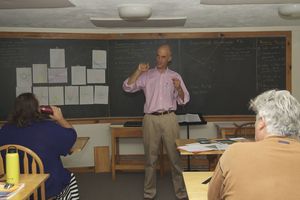 For the 19th year in a row, the CfA’s Waldorf High School Teacher Education Program (WHiSTEP) will launch a new summer session for prospective and practicing high school teachers. Douglas Gerwin, founder of this program, briefly previews the forthcoming cycle.
For the 19th year in a row, the CfA’s Waldorf High School Teacher Education Program (WHiSTEP) will launch a new summer session for prospective and practicing high school teachers. Douglas Gerwin, founder of this program, briefly previews the forthcoming cycle.
The next round of our three-summers program starts in July 2013 on the campus of High Mowing School, a Waldorf school in Wilton, New Hampshire. As in previous years, we will be offering specialization in:
- Arts/Art History –– with Patrick Stolfo
- Biology and Earth Science –– with Michael Holdrege
- English & Foreign Languages –– with David Sloan
- History and Social Science –– with Meg Gorman
- Mathematics and Computer Studies –– with Jamie York
- Physics and Chemistry –– with Michael D’Aleo
The schedule is arranged in such a way that students can specialize in either one or two of these areas.
The program, begun in 1996, also features hands-on seminars in “Living Thinking” with Michael D’Aleo, “Human Development and Waldorf High School Curriculum” with Douglas Gerwin, and “Professional Research” with Michael Holdrege, as well as workshops in drama (David Sloan), eurythmy (Laura Radefeld), music (Jeff Spade), sculpture (Patrick Stolfo), and speech (Daniel Stokes).
In addition to these three summer intensives, students undertake two years of independent studies including a research project and internship. At present over 75 graduates from this program are working in more than 30 Waldorf schools across North America.
Details of our forthcoming summer program––starting on Sunday 30 June and running until Saturday 27 July––can be viewed on our website: www.centerforanthroposophy.org.
Dateline Freeport, ME: Voices of Foundations
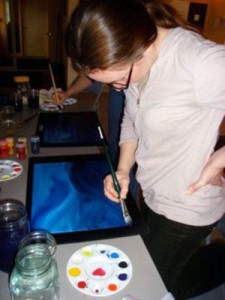 Reflecting upon their one or two years of Foundation Studies in Anthroposophy and the Arts, participants offer vignettes of their experience in one of the eight clusters offered this year.
Reflecting upon their one or two years of Foundation Studies in Anthroposophy and the Arts, participants offer vignettes of their experience in one of the eight clusters offered this year.
On the “Four Temperaments and Eurythmy” with Susanne Zipperlen:
Susanne was able to bring a deeper understanding of the temperaments as well as content from past Foundation Studies lectures to my mind. It is all so inter-related and complex, but her delivery made it easier to understand.
– Mia Ulmer, St. Louis, MO Foundation Studies Cluster
“Art Rejuvenation” with Tom Clark:
The workshop was well organized, each section easily flowed into the next. It was helpful to see the challenges that arise while working with different mediums – drawing, painting, and clay.
A big cosmic thumbs up!
I was made to feel comfortable in approaching the art so I wasn’t hung up on the process, because I was already in the project/work.
– Angie Meara, St. Louis, MO Foundation Studies Cluster
“School Renewal” with Torin Finser:
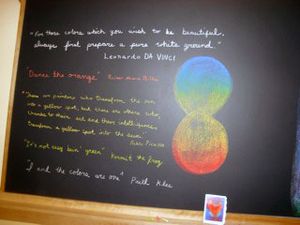 Coming into Foundation Studies, I was a novice parent hoping to understand more about the philosophy that created the Waldorf School. I left being so much more. I was inspired to continue asking questions of myself and others. I met and got to know the most amazing teachers, parents, and students. I was challenged and encouraged to go outside my comfort zone time and time again.
Coming into Foundation Studies, I was a novice parent hoping to understand more about the philosophy that created the Waldorf School. I left being so much more. I was inspired to continue asking questions of myself and others. I met and got to know the most amazing teachers, parents, and students. I was challenged and encouraged to go outside my comfort zone time and time again.
– Kimberly Smith, Freeport, ME Foundation Studies Cluster
“Biodynamics” with Mac Mead and Megan Durney:
We covered the history of Biodynamics, the relationship of the plant to the cosmos, and the relationship of plant to the human being; the relationship of Biodynamics to other forms of agriculture. Both of these presenters were great. I especially enjoyed making the Biodynamic preparation and applying it to the compost pile with Mac.
– Louise Spear, Hadley, MA Foundation Studies Cluster
Dateline Wilton, NH: Final Call “To Lighten the Path”
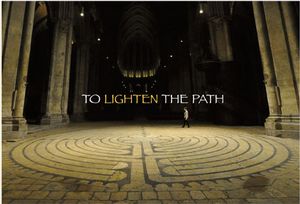 Thanks to the generosity of a widening circle of donors, the CfA’s annual campaign is closing in on its goal for this year. Here is a brief update.
Thanks to the generosity of a widening circle of donors, the CfA’s annual campaign is closing in on its goal for this year. Here is a brief update.
Under the banner “To Lighten the Path”, the Center for Anthroposophy launched its annual appeal around the time of the fall equinox to raise funds for teacher training scholarships. Using as its symbol a small figure making its way around a giant labyrinth, the appeal made the case that financial scholarships lighten the step as well as the path towards becoming a Waldorf teacher.
As we pass through the spring equinox and into the final months of this school year, the annual appeal has reached just beyond 90% of its goal of $40,000. Among contributors to this year’s fund, a fifth so far are first-time participants, and about half of repeat donors have increased their gift over last year.
With just three months to go, we are optimistic about reaching and even surpassing our goal. Please join the final stage of this campaign by donating to the CfA annual fund via this secure link.
Thank you.
Dateline Wilton, NH: Springing Off the Shelves of the Color Shop & More
 In preparation for the spring season, the Color Shop & More is stocking up on new lines of books, toys, and birthday gifts. Here is a sampling of new inventory.
In preparation for the spring season, the Color Shop & More is stocking up on new lines of books, toys, and birthday gifts. Here is a sampling of new inventory.
With an eye on spring and summer, the Color Shop & More has filled its shelves with a new line of beautifully illustrated children’s books, along with an array of flying machines, origami sets, puzzles, and kits for all ages.
For adults, the store has acquired a new selection of recently published books on Waldorf education and anthroposophy, including texts used in the Center’s foundation studies and teacher education programs.
The store has also restocked its arts supplies with new materials including a new line of high-quality paintbrushes.
Hours for the store are Tuesday-Friday from 11:00 a.m. to around 5:00 p.m. and Saturday from 10:00 a.m. to 4:30 p.m. For placing orders, contact the staff at (603) 654-6297 or via e-mail at info@colorshopandmore.com.
